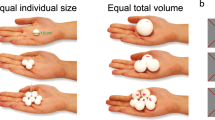Abstract
How do we achieve unitary perception of an object when it touches two parts of the sensory epithelium that are not contiguous? We investigated this problem with a simple psychophysical task, which we then used in an fMRI experiment. Two wooden rods were moved over two digits positioned to be spatially adjacent. The digits were either from one foot (or hand) or one digit was from either foot (or hand). When the rods were moving in phase, one object was reliably perceived. By contrast, when the rods were moving out of phase, two objects were reliably perceived. fMRI revealed four cortical areas where activity was higher when the moving rods were perceived as one object relative to when they were perceived as two separate objects. Areas in the right inferior parietal lobule, the left inferior temporal sulcus and the left middle frontal gyrus were activated for this contrast regardless of the anatomical configuration of the stimulated sensory epithelia. By contrast, the left intraparietal sulcus was activated specifically when integration across the midline was required, irrespective of whether the stimulation was applied to the hands or feet. These results reveal a network of brain areas involved in generating a unified percept of the presence of an object that comes into contact with different parts of the body surface.


Similar content being viewed by others
References
Amedi A, Jacobson G, Hendler T, Malach R, Zohary E (2002) Convergence of visual and tactile shape processing in the human lateral occipital complex. Cereb Cortex 12:1202–1212
Braddick OJ (1980) Low-level and high-level processes in apparent motion. Philos Trans R Soc Lond B Biol Sci 290:137–151
Critchley M (1953) The parietal lobes. Hafner, New York
Disbrow E, Roberts T, Poeppel D, Krubitzer L (2001) Evidence for interhemispheric processing of inputs from the hands in human S2 and PV. J Neurophysiol 85:2236–2244
Gao JH, Parsons LM, Bower JM, Xiong J, Li J, Fox PT (1996) Cerebellum implicated in sensory acquisition and discrimination rather than motor control. Science 272:545–547
Heekeren HR, Marrett S, Bandettini PA, Ungerleider LG (2004) A general mechanism for perceptual decision making in the human brain. Nature 431:859–862
Hyvarinen J (1982) Posterior parietal lobe of the primate brain. Physiol Rev 62:1060–1129
Ivry R (1997) Cerebellar timing systems. Int Rev Neurobiol 41:555–573
Iwamura Y, Iriki A, Tanaka M (1994) Bilateral hand representation in the postcentral somatosensory cortex. Nature 369:554–556
Kitada R, Kochiyama T, Hashimoto T, Naito E, Matsumura M (2003) Moving tactile stimuli of fingers are integrated in the intraparietal and inferior parietal cortices. Neuroreport 14:719–724
Morcom AM, Fletcher PC (2007) Does the brain have a baseline? Why we should be resisting a rest. Neuroimage 37:1073–1082
Reed CL, Caselli RJ (1994) The nature of tactile agnosia: a case study. Neuropsychologia 32:527–539
Reed CL, Caselli RJ, Farah MJ (1996) Tactile agnosia. Underlying impairment and implications for normal tactile object recognition. Brain 119:875–888
Schmahmann JD (2004) Disorders of the cerebellum: ataxia, dysmetria of thought, and the cerebellar cognitive affective syndrome. J Neuropsychiatry Clin Neurosci 16:367–378
Shafritz KM, Gore JC, Marois R (2002) The role of the parietal cortex in visual feature binding. Proc Natl Acad Sci USA 99:10917–10922
Vallar G (1997) Spatial frames of reference and somatosensory processing: a neuropsychological perspective. Philos Trans R Soc Lond B Biol Sci 352:1401–1409
Wardak C, Olivier E, Duhamel JR (2002) Saccadic target selection deficits after lateral intraparietal area inactivation in monkeys. J Neurosci 22:9877–9884
Whitsel BL, Petrucelli LM, Werner G (1969) Symmetry and connectivity in the map of the body surface in somatosensory area II of primates. J Neurophysiol 32:170–183
Wing AM, Bracewell RM (2009) Motor timing. In: Squire LR (ed) Encyclopedia of neuroscience, vol 5. Academic Press, Oxford, pp 1067–1075
Acknowledgments
This work was supported by a European Commission grant to AW and RMB (IST-2001-38040).
Author information
Authors and Affiliations
Corresponding author
Rights and permissions
About this article
Cite this article
Peelen, M.V., Rogers, J., Wing, A.M. et al. Unitary haptic perception: integrating moving tactile inputs from anatomically adjacent and non-adjacent digits. Exp Brain Res 204, 457–464 (2010). https://doi.org/10.1007/s00221-010-2306-3
Received:
Accepted:
Published:
Issue Date:
DOI: https://doi.org/10.1007/s00221-010-2306-3




